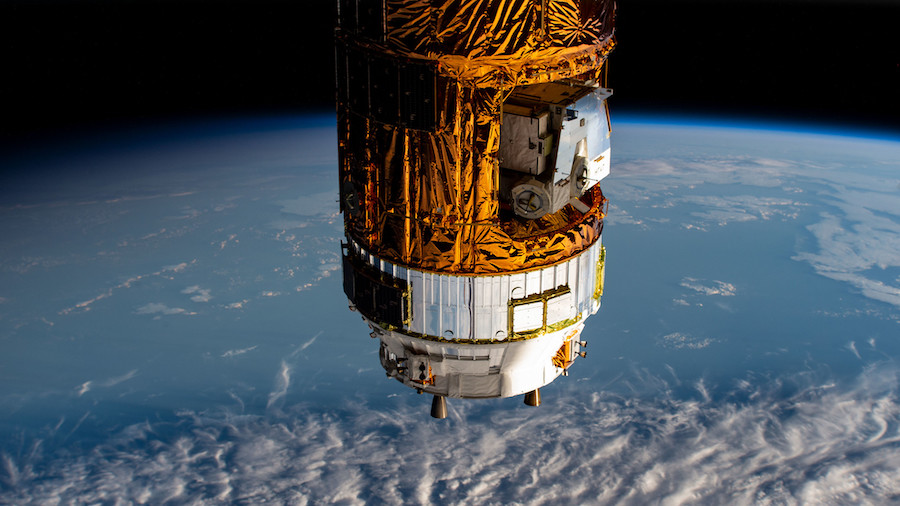Japanese cargo freighter departs space station – Spaceflight Now
EDITOR’S NOTE: Updated at 1:40 p.m. EDT (1740 GMT) after HTV release.

A Japanese HTV cargo freighter departed the International Space Station Friday and headed for a destructive re-entry, disposing of trash and obsolete solar array batteries replaced with more capable power packs on a series of spacewalks outside the orbiting research lab.
Astronauts Christina Koch and Jessica Meir commanded release of Japan’s eighth H-2 Transfer Vehicle at 1:21 p.m. EDT (1721 GMT) Friday from the space station’s Canadian-built robotic arm.
Before the HTV’s departure, ground controllers used the 57.7-foot (17.6-meter) robotic arm to detach the cargo ship from the station’s Harmony module and maneuver the vehicle to a release point below the complex. After the robotic arm released the HTV, the spacecraft fired thrusters to depart the station’s vicinity.
The unpiloted cargo ship arrived at the station Sept. 28, four days after launching from the Tanegashima Space Center in Japan aboard an H-2B rocket. The eighth HTV, also known as Kounotori 8, delivered 8,326 pounds (3,777 kilograms) of equipment, experiments and crew provisions to the orbiting outpost.
Kounotori means “white stork” in Japanese.
The HTV’s cargo delivery included six upgraded lithium-ion batteries for the space station’s outboard port-side solar array module, which has solar wings that span 240 feet (73 meters) tip-to-tip. Astronauts installed three of the new batteries in place of six less capable nickel-hydrogen batteries on two spacewalks in October, but a problem with a battery charge-discharge unit interrupted the battery swapouts before they could be completed.
Koch and Meir performed the first all-female spacewalk in history Oct. 18 to replace the failed battery charge-discharge unit. The other three lithium-ion batteries to be installed on the far port-side solar array truss, known as P6, will be stored outside the station until astronauts can perform at least two additional spacewalks to connect them to the research lab’s solar power network.
Those battery replacement spacewalks, originally planned for the second half of October, will likely be deferred until early 2020, NASA officials said earlier this week. Managers are prioritizing another series of spacewalks, set to begin in mid-November, to repair the Alpha Magnetic Spectrometer particle physics experiment outside the station.
NASA is in the process of replacing 48 nickel-hydrogen batteries with 24 more powerful lithium-ion power storage units on the space station’s four huge solar array modules. Two previous HTV flights in 2017 and 2018 each delivered six new batteries, and the ninth HTV mission set for launch in May 2020 will carry up the final set of six lithium-ion power packs.
The HTV cargo freighter departed Friday carrying a pallet loaded with disused nickel-hydrogen batteries replaced with the lithium-ion units delivered by last year’s HTV-7 mission.
The old batteries, along with the rest of the HTV spacecraft, will burn up during re-entry into the atmosphere late Saturday, U.S. time, over the remote South Pacific Ocean.

After extracting the pallet loaded with the new lithium-ion batteries, the station’s robotic arm placed the cargo pallet with the old batteries into the HTV’s unpressurized payload bay.
The pallet aboard the HTV-8 spacecraft for Friday’s departure actually launched with the HTV-7 mission last year, but remained on the station after NASA delayed last year’s round of battery replacement spacewalks in the wake of a Soyuz launch failure in October 2018.
NASA astronaut Nick Hague and Russian cosmonaut Alexey Ovchinin safely landed in Kazakhstan after the Soyuz launch abort, but the event disrupted the station’s operations schedule, preventing the crew from conducting the battery changeout spacewalks until after the HTV-7 spacecraft’s departure.
In addition to the batteries, the HTV-8 spacecraft is packed with trash and other equipment tagged for disposal.
The battery pallet that flew to space on the HTV-8 cargo freighter will be disposed on a future HTV mission.
A fresh cargo delivery is due to arrive at the space station Monday with the rendezvous of a Northrop Grumman Cygnus supply ship. The Cygnus is scheduled for liftoff Saturday aboard an Antares booster from Wallops Island, Virginia.
Email the author.
Follow Stephen Clark on Twitter: @StephenClark1.





